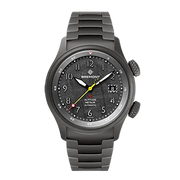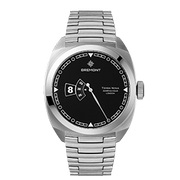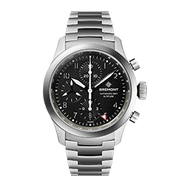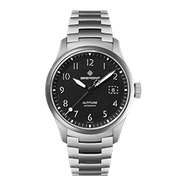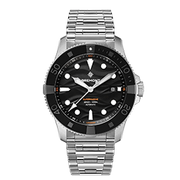Humans have always longed to explore air, land, and sea. The oceans have an extra special and enigmatic allure. Covering 71 percent of the Earth, it remains one of the most inhospitable environments to immerse ourselves in. Submerging ourselves beneath its surface for what should be humanly impossible lengths of time has a particular pull for many. Finding extraordinary means to explore ever further, wider and deeper, fuelling our passion for discovering ever more innovative ways to follow these dreams and push the limits of what’s possible.
The realm of dive watches is especially fascinating, as watchmakers are constantly pioneering ground-breaking features on these highly specialised watches that allow us to explore deeper ocean depths and more challenging conditions than ever before. Whether motivated by the needs for military application, deep water exploration or that of the recreational diver, the popularity of the diving watch has consistently evolved.
Pioneering techniques and the development of materials to adapt to incredible pressures, whilst enabling the watch to become a stylish and hugely sought-after luxury in the modern world is no mean feat. The evolution of this segment of the watch industry is almost unmatched.
The main period of functionality and design development came through the 1950’s and 60’s when many industry icons were born. These encouraged the practicality of having a watch which was easy to read, easy to use and stylish, whether in or out of the water, to become part of our desire to own a dive watch – as well as the association with the rugged environment and pushing our own limits.
Over the years, Bremont has developed its Supermarine Dive Watches Collection to the exacting specifications required for professional divers and military personnel, having worked with the likes of the Royal Marines Commandos, UK and US Special Forces and North Sea Deep Sea Divers.

North Sea Deep Sea Divers watch based on the Bremont S500
For example, in 2014, Bremont worked with the Royal Navy Clearance Divers, an elite team responsible for mine clearance operations based in Portsmouth, to produce a bespoke version of the S500 dive watch. As a team reliant on durability and exacting precision in extreme environments, the S500 delivered the functional and aesthetic properties required for their missions.
Royal Navy Clearance Divers wearing the bespoke S500 and the commercially available S502 JET
Bremont has also worked closely with open water swimmers, free divers, scuba divers, and professional sailing teams to ensure their watches can be relied on in even the most challenging nautical environments. When we say ‘Tested Beyond Endurance’, we mean it.

In 2018, Bremont worked with free-diver Mark Healey to produce the Waterman Limited Edition, a timepiece that had to withstand significant time in the oceans and provide utmost accuracy when breath-hold diving.
Across the globe, some extraordinary men and women are highly regarded for their almost “superhuman” ability to be at one with the ocean. One such world-renowned “waterman” is Laird Hamilton, big wave surfer and ambassador for Bremont’s Waterman Apex dive watches. Known for taming some of the planet’s largest waves, Laird has put this limited edition watch through its paces in the most gruelling conditions.
The Waterman Apex, tested and worn by Laird Hamilton, arguably one of the greatest Watermen and Big-Wave Surfers of all time.
A glimpse back in time into dive watch history
There’s just something imperceptibly alluring and evocative about dive watches. With a rich and fascinating history, they’ve become iconic and sought after both above and below the water.
By the mid-20th century, the popularity of diving was surging. Necessity being the mother of invention, divers needed specific tools to accomplish feats previously considered reserved for creatures with fins and gills. As much as it was a sport, diving pushed the boundaries of science, propelling pioneering developments in diving equipment. In the age before computers and digital devices, divers needed a reliable and highly water and water-pressure-resistant watch, as it could literally mean the difference between life and death.

Royal Navy Clearance Divers putting the Bremont Argonaut to the test
Early 20th-century dive watches were developed to meet the needs of the navy and professional divers. Rotating dive watch bezels were introduced in tandem with the then-new sport of SCUBA diving in the early 1950’s to track a diver’s bottom time - the total time spent underwater. The bezel was a reminder to prevent divers from exceeding their diving time limit with limited oxygen.
This ingenious device could help track how long a diver was beneath the surface, allow the diver to keep track of how much air was in the tank and help calculate decompression stops (to avoid the bends).

What is a bezel?
There are three stylistic hallmarks of the modern diving watch; large, easy-to-read dials, luminescent markers, and unidirectional rotating bezels. While the first two are found in watches not specifically designed for diving, the last plays a vital role in divers' safety and is almost exclusively found on timepieces whose natural habitat is the deep blue.
A rotating bezel is a ring of metal around the watch, traditionally set with crystal. It is held in place using a ratchet and spring, a mechanism that gives the bezel its characteristic clicking sensation while also holding it in place. The bezel secures the crystal to the case assembly and protects the edge of the crystal from impact, providing some protection to the crystal from abrasion and glancing knocks.

There are two kinds of rotating bezels. A unidirectional bezel (one that can move only in a single direction, for diving its counter-clockwise) and a bidirectional bezel (one that can move in both directions).
The unidirectional rotating bezel is a crucial design element of Bremont’s Supermarine Collection diving watches. Since the unidirectional bezel rotates counter-clockwise, it’s a safer means of tracking bottom time. If the bezel is inadvertently moved underwater, it would only shorten the remaining dive time instead of lengthening it – with less disastrous consequences.
Today, most newly released luxury dive watches with rotating bezels are unidirectional and the material used in these precision bezels is ceramic or sapphire for exceptional durability.

External vs Internal Bezels
The two different dive watch bezel types are the more common external bezel and an inside variant introduced further down the line. The internal bezel is fitted beneath the watch glass and is controlled by a separate crown, whereas the external bezel is set on top of a watch. This internal rotating bezel can be seen on the Bremont Argonaut dive watches, for example.

External bezel shown on the S500 vs Internal bezel shown on the Bremont Argonaut
Luminescent Markers

Super-LumiNova® featured on the Supermarine S502 JET
Visibility substantially decreases the deeper you dive. Visible light has different wavelengths, each penetrating water to different depths. Hence, a diver loses different colour reflections the deeper they dive. It follows the rainbow sequence, with red being the first hue lost at around 5-10m, depending on conditions. One does not need to journey too deep, therefore, before natural light can no longer be relied upon to illuminate the dial of a diver’s watch. An alternative method would be called upon to light the way for the trailblazers of the deep.
Dive watches fitted with a bezel containing luminescent minute markers circumvent this problem. Even those with only a luminous dot on the zero bezel marker and luminous hands can accurately track time.
Distinguishable markings on the watch face are a key design requisite on Bremont’s iconic Supermarine Collection diving watches. The luminosity of a watch depends on the pigments that have compounds that, after charging from a light source, emit a glow for several hours. As many as 15 to 20 coats of Super-LumiNova® are meticulously applied to the dials of Bremont’s dive watches. This ensures optimal visibility in the poorest of lighting conditions.
The Bremont Supermarine Diving Watches Collection was named as a tribute to the iconic British aircraft manufacturer responsible for the Supermarine S6B Schneider Trophy Seaplane and, of course, the incredible Supermarine Spitfire.

Bremont’s deepest dive watch, the S2000
A deep dive into the fascinating world of diving watches and bezels
Luxury dive watches are not only designed to be visually appealing but also built to handle just about anything. The rounded glass face, thick strap, and large, easy-to-read dial are essential components in salty and surreal underwater realms.
Diving watches have a fixed number of divisions on the edge, typically specified in position. They help divers measure elapsed time underwater, significantly minimising the risk of injury or even death. Dive bezels include grooves, so they are easier to grip and rotate in more demanding surroundings, i.e., at greater depths underwater whilst wearing diving gloves. It may seem straightforward in terms of execution and design, but a rotating time bezel saves the diver from having to do any complicated mathematical calculation in their head.

How to use a rotating bezel
Whether you’re new to a diving sport or a professional saturation diver with years of experience under your diving weight belt, you’re probably acutely acquainted with the concept of bottom time. This is the entire time spent from the start of your descent to the start of your ascent. The rotating bezel of a diver’s watch can be used to determine the time spent at the bottom. You should know how a dive watch bezel works regardless of whether or not you’re plunging off the side of a dive boat. You’d be amazed to realise how indispensable a dive watch bezel can be in everyday life.
Step 1:
The wearer twists the bezel just before the first drop so the minute hand and the zero indicator, usually clearly evident in some way (such as a luminous pip inside a triangle), are lined up.

Step 2:
Next, subtract the number of minutes before you need to start surfacing, your ‘air time’, from 60. For example, on a 20 minute dive you would subtract 20 from 60 to give 40. Now rotate the bezel so the minute hand aligns with that number.

Step 3:
During the dive, the minute hand revolves around the dial in the usual way as time elapses. When the minute hand gets to the dive marker position, you will need to resurface as this indicates your dive time is up.

As an extra precaution, a helium release valve is fitted to the Bremont S500 and S2000 ranges (such as the striking new addition to the S500 range, the Supermarine Descent II). This prevents the crystal from being blown out by an internal pressure build-up caused by helium seeping into the watch case.

For more insights into luxury dive watches, dive into the world of Bremont Watches by signing up for the Club Bremont newsletter. Here you’ll find the latest in exciting new developments, product launches, and noteworthy milestones from Bremont.
The deep blue sea is waiting to welcome you, so explore the iconic Bremont Supermarine Collection and uncover your unique underwater timepiece.












